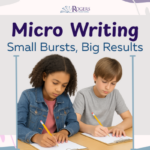Recently, I had the chance to collaborate with a campus on incorporating Close Reading techniques into their reading block to enhance comprehension. Here’s an example of a week-long lesson plan we developed. Feel free to reach out if you’re interested in exploring similar strategies for your school.
Objective:
Students will closely read The Story of an Hour by Kate Chopin to analyze the text’s themes, characters, and use of literary devices, culminating in a deeper understanding of the protagonist’s emotional journey and the story’s commentary on freedom and identity.
Materials:
- Copies of The Story of an Hour by Kate Chopin
- Highlighters and pens
- Pre- and Post-Annotation cards
- Notebooks or journals
Introduction:
- Hook: Begin with a brief discussion about the concept of freedom. Ask students, “What does it mean to be truly free? Can freedom be both joyous and terrifying?”
- Context: Provide a brief background on Kate Chopin and the historical context of the story. Mention the constraints faced by women in the 19th century and how these constraints might impact their sense of identity and freedom.
Day 1: Literal Understanding and Theme
- First Read:
- Setup: Students read the text, paying attention to the literal meanings and considering the theme of freedom.
- Text-Dependent Questions:
- How does Mrs. Mallard initially react to the news of her husband’s death?
- What sequence of events follows her reaction, leading up to her time alone in her room?
- Activity: Inside/Outside Circle
- Students form two concentric circles, with those in the inner circle facing outward and those in the outer circle facing inward. Each student shares their responses to the questions with their partner. After a few minutes, the outer circle rotates so students discuss with a new partner.
Day 2: Vocabulary and Author’s Craft
- Prompt: Encourage students to think about the rich vocabulary and the author’s craft.
- Second Read: Students read the text again, focusing on specific vocabulary and the text’s structure.
- Text-Dependent Questions:
- What does the word “elixir” mean in the context of Mrs. Mallard’s reaction to her newfound freedom?
- How does Chopin’s use of imagery (e.g., descriptions of the spring day, the open window) enhance the story’s theme?
- How does the structure of the story, with its brief, concise paragraphs, contribute to its overall impact?
- Discussion:
- Structure: Small group discussions where each group is assigned one question. Groups discuss and then present their insights to the class. Ensure that each student in the group has a role, such as note-taker, presenter, or discussion leader.
- Text-Dependent Questions:
Day 3: Deeper Meaning and Logical Inferences
- Prompt: Get students to think about the deeper meaning of the text and to create logical inferences.
- Third Read: Students read the text again, this time considering the author’s purpose and making connections to similar themes or ideas.
- Text-Dependent Questions:
- What is Chopin’s purpose in writing this story? What message is she conveying about marriage and individual freedom?
- How does the story’s ending impact your understanding of Mrs. Mallard’s character and her initial reaction to her husband’s death?
- Identify any rhetorical structures in the text that contribute to its meaning. How do these structures support Chopin’s themes?
- Activity:
- Students work in small groups to discuss their answers. Each group creates a poster summarizing their discussion, which they then present to the class.
- Text-Dependent Questions:
Day 4: Evaluation and Personal Response
- Evaluation: Students evaluate the text and form opinions about it.
- Activity: Structured writing response where students answer the following prompts:
- Do you think Mrs. Mallard’s reaction to her husband’s death is realistic? Why or why not?
- How does the story challenge or reinforce your own views on marriage and freedom?
- Students write their responses individually, focusing on providing textual evidence to support their opinions.
- Activity: Structured writing response where students answer the following prompts:
Day 5: Final Discussion and Presentation
- Activity:
- Students share their written responses in small groups, discussing the different perspectives and interpretations.
- Each group selects one or two responses to share with the class in a final discussion.
- As a class, discuss the varying interpretations and how each student’s background and experiences might influence their reading of the story.
Assessment:
- Participation in discussions and group work
- Quality of annotations and insights on pre- and post-annotation cards
- Depth of analysis in journal entries or creative responses
- Thoughtfulness and textual support in structured writing responses
Conclusion:
Wrap up the lesson by emphasizing the power of close reading in uncovering deeper meanings within a text. Encourage students to apply these analytical skills to other stories and aspects of their lives, always questioning and exploring beneath the surface.
A Few Novels That Connect:
The Awakening by Kate Chopin – This novel by the same author delves deeply into themes of female autonomy and societal expectations, making it a perfect companion to The Story of an Hour.
The Handmaid’s Tale by Margaret Atwood – This dystopian novel examines themes of female oppression, freedom, and resistance within a repressive society.
Jane Eyre by Charlotte Brontë – This classic novel addresses issues of gender equality, personal freedom, and the struggle for self-identity against societal expectations.



